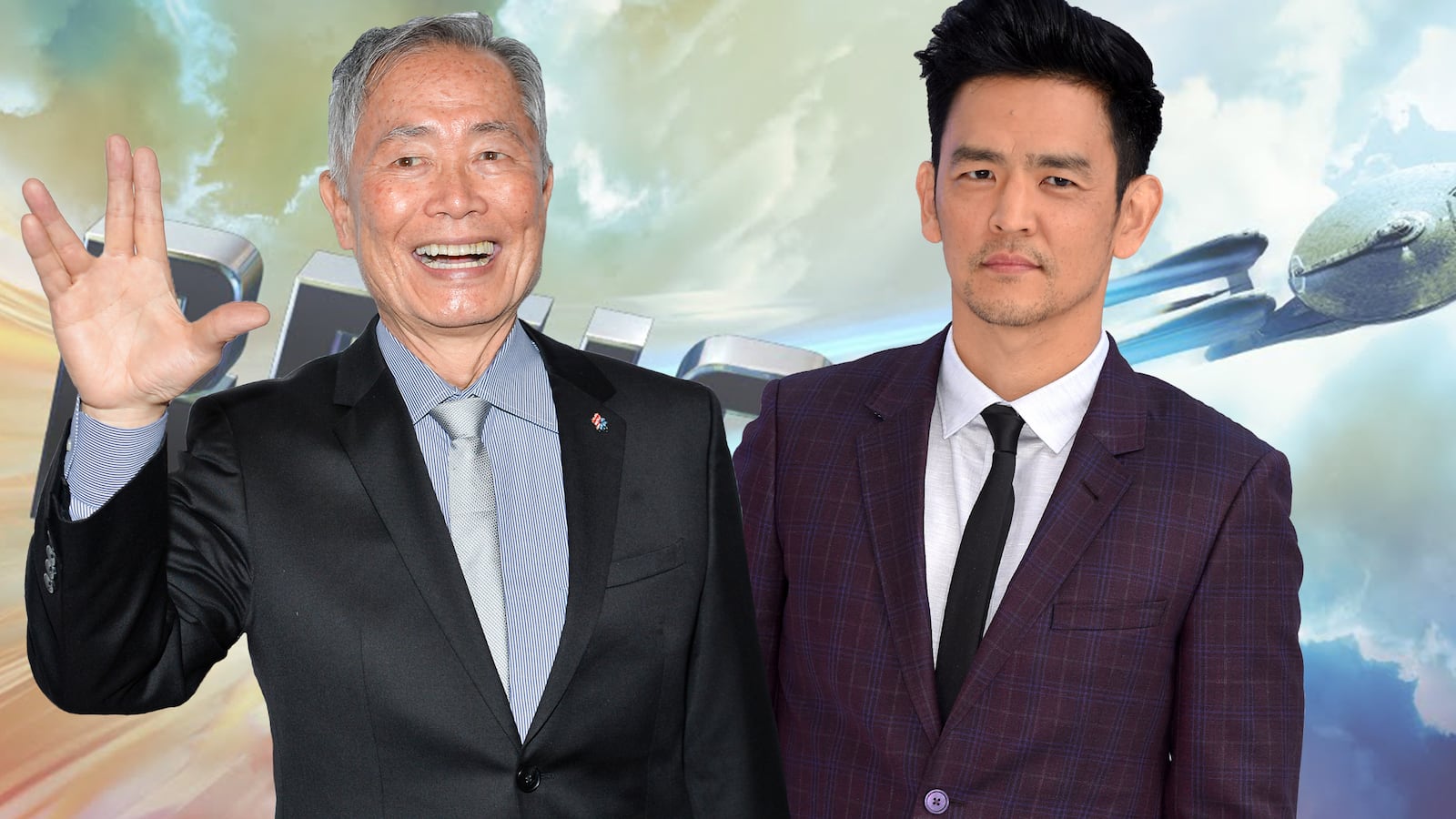When Star Trek Beyond’s Simon Pegg first pitched the idea of making Hikaru Sulu gay in honor of original series star George Takei, he thought the Star Trek icon and LGBTQ activist would love seeing the Enterprise’s helmsman boldly go where no one has gone before in 50 years of Trek: out of the closet.
He was wrong. In an interview with The Hollywood Reporter, Takei, who came out in 2005, praised the J.J. Abrams-produced reboot franchise for being LGBT inclusive but called the move “really unfortunate.”
“I’m delighted that there’s a gay character,” he said. “Unfortunately, it’s a twisting of Gene [Roddenberry]’s creation, to which he put in so much thought. I think it’s really unfortunate.”
Takei’s public disapproval took the new Enterprise crew by surprise. Pegg hit back in a blog post before he and his co-stars acknowledged the fight over Sulu’s sexual orientation Thursday in Beverly Hills and agreed to keep disagreeing with Takei.
“I thought it was a beautiful idea,” said John Cho, who made his debut as the younger Sulu in 2009’s Star Trek. That film cannily established the current era of Trek films as an alternate timeline in which beloved characters remain essentially the same while their lives are altered from the original continuity.
Cho reprised the role in 2013’s Star Trek Into Darkness, but it’s not until next week’s Star Trek Beyond, directed by Fast & Furious franchise helmer Justin Lin, that Sulu’s private family life with a male spouse and a young daughter is officially revealed.
Both he and Lin discussed the revelation with Takei early on before the Paramount production pressed forward with a script by Pegg and co-writer Doug Jung. It’s Jung who appears as Sulu’s husband in a brief and sweetly straightforward scene carefully designed to make the landmark moment feel utterly normal—a luxury Star Trek creator Gene Roddenberry never had half a century ago.
“I had concerns about how it would be received by George and I had some other concerns but it was really the handling that was important to me,” Cho explained. “Having seen the film I think its nonchalant posture is the best thing about it, and the fact that it’s normalizing it. It’s kind of news now, but if you re-watch the movie in ten years you won’t think anything of it, it’ll just go right by you.”
“Roddenberry did set up a world that was incredibly progressive but it was tempered by the social mores of the era,” Cho added, addressing journalists Thursday. “And I feel that we can go further in 2016 than he was able to do at the time. Our version is able to give more to women and people of color than Roddenberry was able to… not because he didn’t want to.”
“He absolutely wanted to,” Pegg added.
“It wasn’t just that we revealed that he’s gay,” said Zoe Saldana, who plays Lt. Uhura, the communications officer at the center of the groundbreaking interracial kiss that sent audiences and censors into a tizzy in 1968. “We revealed he’s a father. So I feel quite puzzled that in 2016 we’re having a bit of a fit over who he fathered a baby with.”
Pegg expanded on the gay Sulu controversy to The Daily Beast, assuring that there’s no beef or animosity with Takei over the issue. “We were quite surprised when he was sort of unsure about it,” he said.

In 2016, and with Star Trek Beyond arriving in theaters weeks after Ghostbusters takes a bold stance for women but whiffs on gay representation, inclusivity on this scale isn’t just homage to Trek lore’s own LGBT icon. It’s an important step toward progress in mainstream studio filmmaking, and a move that might embolden other studios to open the gates of representation on the big screen.
“It felt so right, to make it feel as if it was something that had already existed,” Pegg told The Daily Beast. “Like it wasn’t a new thing. Later we’ll start to talk about interspecies relationships or whatever. But you begin where you can begin, in the most palatable way for an audience for whom this stuff is nascent, to accept it.
As for why Sulu and his Mr. Sulu don’t get more than a tender spousal embrace onscreen, “we had to temper that moment,” said Pegg. “If they had run up to each other and had a massive snog, it would have looked like we were being too demonstrative.”
“We wanted to do it tastefully, not that kissing is not tasteful,” he continued. “But it’s one of those things that you have to pitch exactly right. It needed to be sweet, and it needed to not look as if we were trying to be cool, either. Just be sweet and ordinary, which is what all love is, really.”
“How we approached was to not really make that a big deal out of it,” Jung explained earlier in the day. “To not address it as something that had a spotlight on it felt true to the nature of what Star Trek is but also, to me, felt to me like a natural progression of where we’re headed ourselves in real life.”
“We wanted to do it that way and include it as what it is: a normal thing that exists in the world.”





